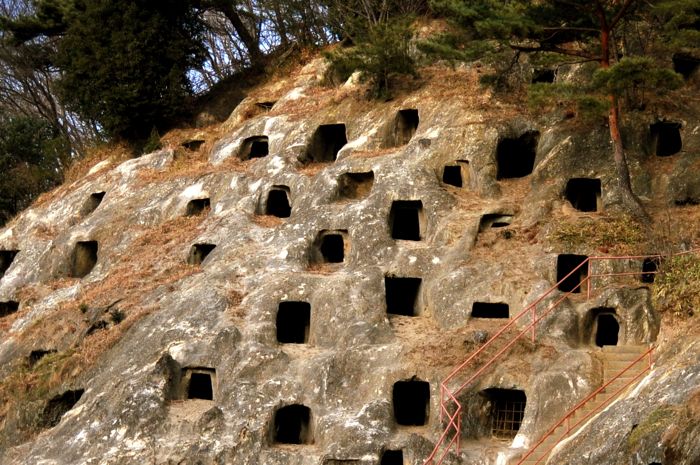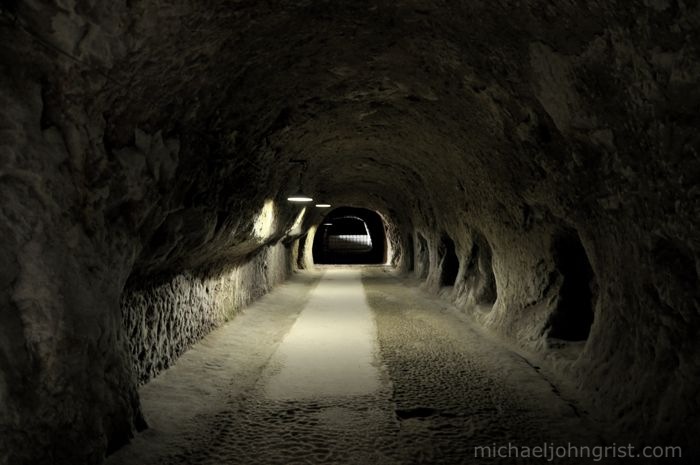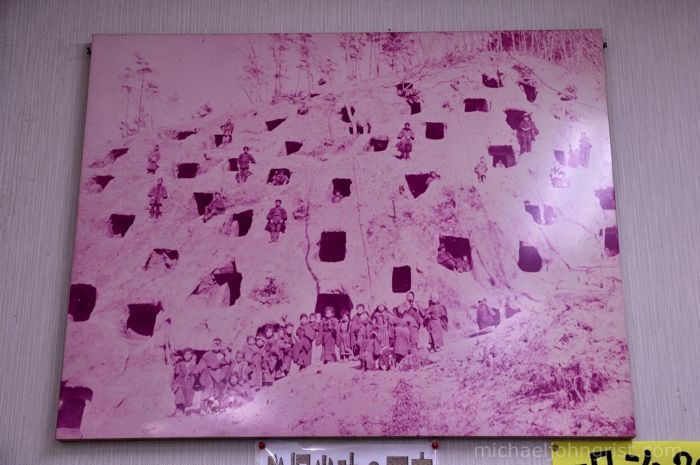The Hyaku Ana Cliff Tombs in Saitama are ancient, easily some of the oldest ruins in all of Japan, dating back 1300 years to a time of almost pre-history- such that very little is known about them at all. They were first discovered in 1888 and thought to be aboriginal homes, only being proved to be tombs after a research study in the 1920’s. A second layer of history was added in the Second World War when deep munitions tunnels were carved into the rock; gloomy storage spaces to keep serious weaponry safe from Allied bombing raids. Now the tunnels are well-lit and echo with the sound of clattering children chasing each other from end to end, the deeper recesses fenced off with metal portcullis walls.

Hyaku Ana Cliff Tombs.
This haikyo was a tourist attraction- albeit one somewhat off the beaten track and not so well known. I went with SY after checking out the Gan Kutsu Cliff Face Hotel – from there we spotted all these myriad holes in the cliff nearby and went to take a look. We paid admission and explored the nicely stair-cased cliff-face and well sign-posted tunnels alongside other couples and families with kids.
Other explorers wend in and out of the tunnels and tombs.
This is an a-typical haikyo for this site as there is no element of infiltration. Some might then think it’s not proper ‘urban exploration’, but I don’t define what I do as ‘urbex’ so I don’t worry too much about that. Infiltration does add more excitement to a haikyo, but it’s only one element in the whole package, you still have exploration of a place new to you, the interest in the place’s history, the challenge of capturing it in photographs.
Stair-case leading up the cliff.
Hyaku Ana means 100 holes, but there are actually 262 tomb-holes in total. 100 is just a convenient number and makes for a good name.
Holes up the side like stadium-seating, with stair-cases.
After looking over the exterior for a while, we delved deeper inside.
An entrance to the military tunnels.
.
Inside, light and shadow split the tunnel into zones.
.
Some small fence-work in the middle, I generally disregarded it.
.
To a portcullis at the end.
.
Portcullis blocking the path.
.
Beyond the portcullis, perhaps a dead-end anyway.
.
Looking back out- you can see the tunnel is pretty huge.
.
A back-lit SY.
After walking the tunnels for some time, enjoying the intervals of dim silence when fellow explorers and their kids had stepped out, we emerged back into the light and climbed up the cliff-face to take a closer look at the individual tombs.
A wall cross-hatched with words, drawings.
.
Closer up it looks crazy.
.
I wonder who G.H. is, and how long ago he/she was here.
After tromping around on top for a while we decided to head out, but got way-laid en route by the on site snack-vendor, who salted his sales pitch for local ‘omiyage’ or souvenirs with historical information- pointing us to old photos hung from the walls of his shop. A very clever sales pitch, I thought- SY ended up buying some locally made ‘sembe’ rice crackers from him.
The fullness of Hyaku Ana before development as a tourist site.
.
Locals posing in front of the tombs.
.
I’m not sure about this, perhaps a rendering of what Japanese aboriginals looked like.
.
Looks like a military chap.
.
The photo wall.
.
More locals. I guess they’re all either very old or dead now.
.
Perhaps in the military era.
.
Finally, a shot of me inside one of the tombs- mostly to give you an idea of their size and depth.
After that, we went home.
FACTFILE
Location – Yoshimi Town, Saitama.
Entry – About 300 yen per adult.
Highlights – Finding it randomly, wandering in out-of-bounds areas within the military tunnels.
RUINS / HAIKYO
You can see all MJG’s Ruins / Haikyo explorations here:
[album id=4 template=compact]























Comments 7
In the picture you’re not sure about, people are just wearing regular clothes for the era. The straw clothes were often used as protection against the rain. Probably just local famers 😉 Great review, I’m definitely going!
If the barricade is fixed in place, and doesn’t slide up, it’s not a “portcullis.”
Archeological tourism more then haikyo. Pretty cool. I did not know about this place. All the graffiti scratched into the wall looks like hieroglyphics. Too bad GH did not put a date.
Yeah, not the usual haikyo and I’d say Tornadoes got the most appropriate term, “archeological tourism.” I had never heard of this place, would have liked to of gone.
Sooo…..what happened to the bodies that used to be there???
Again, thank you for the virtual tour. Always glad to see posts about places like this because I either don’t know about them or likely will never go in person.
Author
Archaeological tourism right, good call Tornadoes (and Jason). It is different when the place is not properly abandoned, so I wasn’t sure whether I wanted to put this post in my ruins or my structures thread. But, it is ruins even if it is not exactly haikyo, and anyway it doesn’t really matter as either way it’s a fascinating place.
Thanks Kanmuri for the background info, I suppose that makes the most sense, and it’s definitely worth going to. If you feel like hopping over the fence of the Gan Kutsu Rock Hotel and snapping a shot with flash through the bars while you’re there- I’d be very interested to see it 🙂 Mark- way to call me out!
As for the whereabouts of the bodies Lara, almost certainly they’d have decayed to dust a long time ago, even if they hadn’t already been exhumed and discarded by whoever replaced that tribe/civilization.
I wish I had a guide-book filled with off the beaten path places like this, Billy. I have my haikyo guidebook which is great, but for older historical tid-bits I don’t have anywhere to look. Probably if I’m willing to buy a Japanese history guidebook I’ll get that, and even though I won’t understand much of it it’s probably the next step for me.